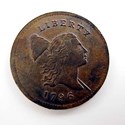The price on January 22 was £225,700 when the 22% buyer's premium was added.
The 1796 'Liberty cap' half cent was found housed in a homemade matchbox cabinet, almost 50 years after its owner died at the age of 20.
In 1796 the Philadelphia Mint was busy producing the first gold coinage of five and ten dollar pieces and the half-cent received relatively little attention. The result of a broken die, there are two variants - one in which the Phrygian or Liberty cap hovers behind the head, the other in which it is suspended from a pole - but both as rare.
The 'with pole' coin, identified by W&W's coin consultant Daniel Fearon, was one of only 1390 struck in pure copper, the work carried out by John Smith Gardner, assistant engraver at the Philadelphia Mint from 1794 to 1796, who was paid between $1.62 and $2.62 per day.
The 1796 'Liberty cap' half cent has always been a rarity in the collectors' market but many of the better specimens have surfaced in Britain where Colonial copper coinage and trade tokens were widely collected at the time.
Provenance
This particular coin, in its original condition with a good even colour, has no early collecting pedigree but was owned by Mark Hillary, a brilliant Oxford classical scholar who died in a climbing accident in Greece at the age of 20 in 1963.
Much of his spare time had been spent at Spink's and Seaby's in London pursuing his hobby of coin collecting and the main part of his collection was sold at Woolley & Wallis a few years ago.
The 'lesser' coins, that formed his original schoolboy collection, were housed in homemade cardboard trays and a 'cabinet' made of matchboxes, which only came to light recently during a clear out of boxes of what was thought to be junk.
That only a handful 1796 half cents have survived in this condition, saw the estimate of £25,000-30,000 quickly eclipsed in a bidding battle filmed for an American audience by CBS News.
The lot finally sold to The Numismatic Financial Corporation of Winter Spring, Florida.
"It was a wonderful result and a most satisfying ending to an amazing find," commented Daniel Fearon.








